Collect and report data on credentials and their value in the marketplace. Not all credentials are created equally, as some actually lead learners toward lower paying jobs. Currently, only about half of states collect information on many credentials such as certificates and industry certifications, and thus have limited data on which credentials are most effective for wage growth. Credential transparency is critical for policymakers to make data-informed decisions about workforce and education investments. Many states are spearheading efforts to identify and then promote credentials of value in the marketplace. With the help of labor market data, states can begin this process by building a cross-sector, priority industry-recognized credential list spanning the education and workforce system.
State Program Examples
-

Indiana
Developed A Statewide Credential Registry
Under Indiana Governor Holcomb’s leadership, Indiana has emerged as a leading state in the Credential Engine initiative to build a public registry of credentials in a linked, open-data format. To date, the state has published information from its public 2- and 4-year institutions and is expanding to include private institutions and non-credit providers. This new data resource will be the foundation for new state and national tools and applications designed to help individuals easily navigate educational opportunities aligned to their career aspirations.
-

Connecticut
Requires Skill and Competency Attainment Transparency
In 2019, Connecticut Governor Lamont signed Executive Order No. 4 requiring the state to “bring transparency to credentials conferred by public higher education institutions by translating credentials wherever possible to the skills and competencies developed to attain those credentials”.











